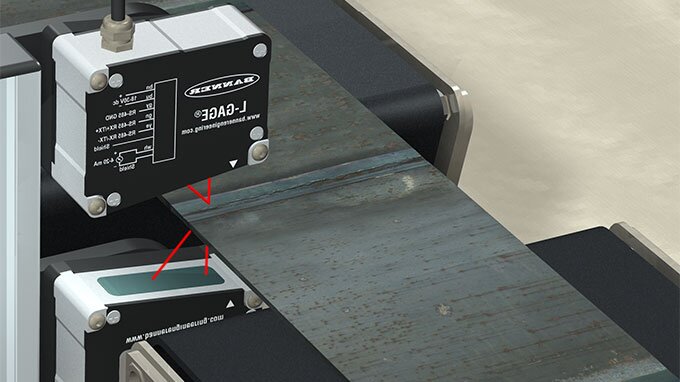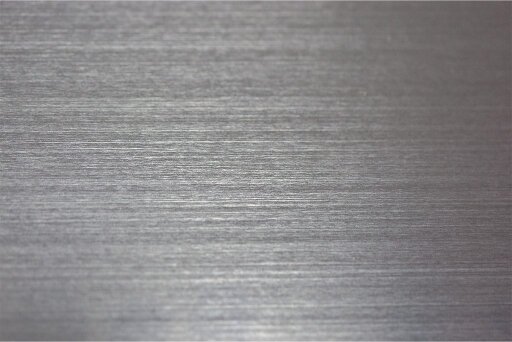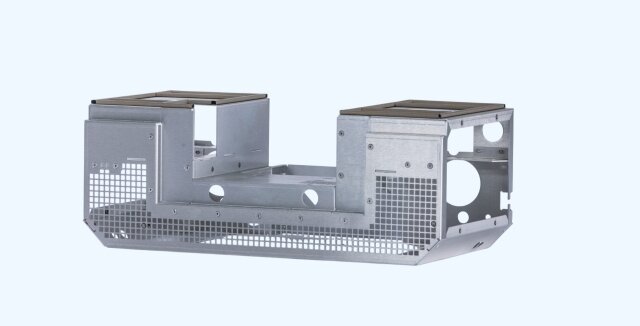水やゴミは屋外機器や産業機器にダメージを与えます。小さな水漏れでも電子機器に害を与え、寿命を縮め、実際の使用で故障を引き起こす可能性があります。密閉型エンクロージャの設計が製品の信頼性に大きな役割を果たすのはこのためです。
多くの設計者はIPまたはNEMA規格を目指している。例えば、IP67のエンクロージャは、すべての埃を遮断し、水深1mで30分間密閉状態を維持しなければなりません。このガイドでは、実際の動作条件下で密閉性を維持するエンクロージャを構築するのに役立つ重要な考え方を説明します。

保護要件の設定
室内空間は安全そうに見えることが多いが、それでもエンクロージャーにとっては問題がある。ホコリは小さな隙間から入り込む。暖かい機器は、筐体内部に湿気を発生させます。近くの機械からの軽い振動で、ネジや金具が徐々に緩むことがある。
屋外での使用はより強いストレスを加えます。雨は様々な方向からエンクロージャーを襲う。風は、きつく見える継ぎ目に水を押し込むことがある。日光は日中金属を加熱する。夜には冷気が金属を収縮させます。この膨張と収縮によってガスケットの圧力が下がり、小さな隙間ができる。直接雨が降っていなくても、水が入り込むことがあります。
沿岸部や工業地帯は、さらなるリスクをもたらす。塩水噴霧は腐食を早める結晶を残す。工場では、エンクロージャーが油、燃料、化学ミストにさらされます。プラスチックは強い紫外線で弱くなる。金属は酸性の空気で強度を失います。振動、衝撃、乱暴な取り扱いにより、ヒンジがずれたり、金具が緩んだりします。これらの変化はシーリングラインを壊し、漏れの可能性を高めます。
ターゲット定格(IPまたはNEMA)の選択
実際の条件に合った定格を選ぶことで、多くの問題を回避することができます。チャート上では問題ないように見える定格でも、製品周辺の実際の危険性に対応していなければ、現場で失敗する可能性があります。
IP等級は、エンクロージャーが埃をどの程度ブロックするかということと、水をどの程度ブロックするかということの2点を示している。
- IP54で、埃や光の飛沫を防ぐ。
- IP65は、ほこりやほとんどの雨や水滴を遮断します。
- IP66で強力な噴流水にも対応。
- 短時間の水没に耐えるIP67。
- IP68は、試験限界に応じて、より深い、またはより長い水没に対応します。
NEMA定格 さらに進んでいる。埃や水をカバーし、腐食も考慮している。
- NEMA 3Rは屋外の雨にさらされる場合に適しています。
- NEMA 4はホースからの水から保護します。
- NEMA 4Xは、海洋や化学エリアでの耐腐食性を追加します。
- NEMA 6および6Pでは短期間の水没が可能。
防水・防塵エンクロージャーの材料選択
素材の選択は、エンクロージャーの水、ほこり、熱、長期使用への対応に影響します。明確な比較は、シールやジョイントを設計する前に安定したオプションを選択するのに役立ちます。
メタル・オプション
金属は過酷な条件下で強力な保護を提供します。衝撃や振動によく耐え、表面を平らに保つので密閉性が高い。
- ステンレススチールは最高の耐食性を提供します。沿岸地域、屋外電力システム、食品用機器に適しています。熱や寒さにも安定した状態を保ちます。また、溶接後のフランジ表面を平坦に保ちます。主な欠点は重量と高いコストです。
- アルミニウムはより軽量な選択肢となります。スチール製よりも耐食性に優れ、コーティングにもよくなじみます。ポール・マウント・ボックス、マシン・カバー、テレコム・ハウジングに適しています。強度はスチール製より低いため、大きなパネルには特別なサポートが必要な場合があります。
- 亜鉛メッキ鋼はバランスの取れた性能を発揮します。亜鉛層は錆びを遅らせ、屋外での適度な使用に適しています。ステンレス鋼よりも安価です。塩水噴霧や化学的環境では、亜鉛層が時間の経過とともに摩耗するため、長持ちしません。
非金属オプション
非金属材料は、重量、コスト、形状の複雑さが重要な要素である場合に役立ちます。プラスチックは、継ぎ目が少なく複雑な形状が可能で、漏れの経路の数を減らすことができます。
- ABSは成形が簡単で低コスト。屋内での使用に適している。屋外では紫外線により脆くなる。
- ポリカーボネート(PC)は屋外でも使用できます。衝撃に強く、熱下でも強度を維持します。照明ハウジング、センサー、計器カバーに適しています。
- ナイロン(PA)は化学薬品や摩耗に強い。水分を吸収するため、コントロールしないとサイズが変化し、フィット精度が低下する可能性がある。
- 複合材料は高い剛性と強い耐食性を提供する。屋外用通信ボックスや船舶用ハウジングに適している。
表面処理とコーティング
コーティングは、水、ほこり、紫外線、化学物質からエンクロージャ素材を保護します。耐用年数を延ばし、シール面を安定させます。
- パウダーコーティング は厚く均一な層を形成する。スチールやアルミニウムを腐食から守ります。また、ガスケットの密閉性を高めるため、表面の粗さを小さくします。エッジ部分には厚いコーティングが付着することがあるため、シール部分には慎重な管理が必要です。
- 陽極酸化処理 はアルミニウムによく効く。腐食や紫外線に強い硬い表面を作ります。屋外環境での孔食を防ぎ、ガスケット接着のための安定した下地を作ります。
- メッキ 亜鉛、ニッケル、クロームなどの方法は、鋼鉄にさらなる保護を加える。亜鉛は湿気に強い。ニッケルやクロムは、工業用や化学的な分野での耐性を高めます。
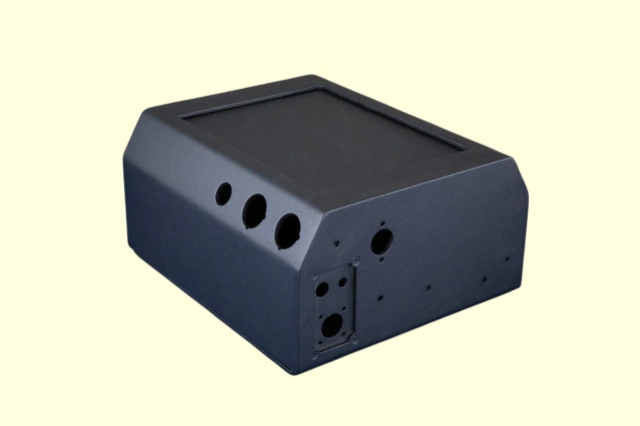
侵入を防ぐ構造設計戦略
優れた構造は、水やゴミをブロックするのに役立つ。囲いの形状とレイアウトは、水の動きと隙間の挙動を導きます。
進入経路の最小化
継ぎ目、ジョイント、小さな界面を減らすことで、漏れのリスクを下げることができる。部品を追加するたびに、新たな隙間が生じます。これらの隙間は、毛細管現象や風圧によって水の侵入を許します。
大きく連続した表面は、ゴミや雨を寄せ付けません。シンプルなパネルは、水が溜まる場所を少なくする。それぞれの曲がりや継ぎ目には明確な目的があるべきである。このアプローチは、屋外での性能をより安定させる。
重なり合うカバーは、複雑なシールなしでプロテクションを追加します。1枚のパネルがもう1枚のパネルからはみ出し、自然なシールドを形成します。水は継ぎ目に向かって流れるのではなく、継ぎ目から逃げていきます。
屋外では下向きの開口部が効果的です。通気口、排水口、ケーブルの引き込み口は下向きにし、雨がまっすぐ内部に落ちないようにする。このシンプルなレイアウトにより、ほとんどの水しぶきによる故障を防ぐことができる。
エンクロージャー周辺の水流管理
表面全体の水の動きを誘導することができる。水の流れを良くすることで、水たまりや水しぶきの侵入を減らすことができます。
傾斜した表面は水の流れを妨げません。わずかな角度でも、水が圧力をかけたり、小さな隙間に到達したりする前に排水するのに役立ちます。平らな面は、水が長時間滞留するため、しばしば問題を引き起こす。
排水路は水をシール部分から遠ざける。小さな水路や溝は、表面を乾燥した状態に保つのに役立ちます。これらの経路は、結露による隠れた湿気も減らします。
遮蔽された開口部は、風による雨を遮断する。通気口の上にある小さなカバーが、流れ込む水の勢いを弱める。このシールドは内部部品を濡らさないようにする。
剛性と寸法安定性の確保
剛性の高いエンクロージャーは、シーリングフランジをフラットに保ちます。平らなフランジはガスケットに均一な圧力をかけます。凹凸のある部分は、水が浸入する低圧スポットの原因となります。
曲げ, 溶接と機械加工によってパネル形状を変えることができる。溶接の熱は金属を内側に引っ張る。鋭い曲げはシートをねじります。薄い部分を機械加工すると剛性が失われる。これらの変化はシーリングの安定性を低下させます。
適切な曲げ半径を使うことで歪みを抑えることができます。半径を大きくすると応力が下がり、フランジをより平坦に保つことができます。荷重でたわむ可能性のある大型パネルには、補強リブを追加することができます。このリブは、組み立て時や実際の使用時にエンクロージャを安定させるのに役立ちます。
シールのデザイン水と瓦礫保護の核心
信頼性の高いシールは、保護されたエンクロージャーの中心に位置します。以下のポイントは、実際のストレスに耐えるシールの選択と設計に役立ちます。
正しいシーリング方法の選択
さまざまな形状、圧力、環境では、さまざまなシール方法がより効果的に機能する。一つのシールであらゆる問題を解決しようとするのではなく、エンクロージャーに合った方法を選ぶべきです。
- ガスケットは平らなドアや大きなパネルによく効く。振動によく耐え、交換も簡単です。厳しい機械加工は必要ありません。
- Oリングは密閉性を高めます。機械加工された溝の中に収まります。接触面積は小さいが圧力が高い、丸いカバーや精密なカバーに最適です。
- フォーム・シールは軽量カバーにフィットする。簡単に圧縮でき、強力なラッチやネジを必要としない。コストは低いが、屋外の過酷な条件下では消耗が早い。
- モールドシールは複雑な形状に適合し、継ぎ目がありません。コストは高くなりますが、高いIP等級や屋外での頻繁な使用に耐える強力な保護を提供します。
ガスケットとOリングの設計原理
正しい圧縮は、優れたシーリングの核心である。圧縮が低すぎると隙間が生じます。圧縮が高すぎると、シールが損傷します。安定した範囲は、長年にわたって安定した性能を維持します。
平らなシール面は非常に重要である。粗い面や凹凸のある面は、漏れの経路となる。パネルは、曲げや溶接後も平らでなければなりません。フランジがきれいだと、故障のリスクが低くなります。
溝のデザインは、Oリングの挙動をコントロールします。溝はO-リングのサイズに合っていなければならず、組み立ての際にO-リングを所定の位置に保持しなければなりません。スペースが広すぎると転がりやすくなります。スペースが少なすぎると、Oリングを挟み込み、寿命を縮めます。
ファスナーの間隔は圧縮に影響します。ファスナーは、均等な圧力がかかるよう十分に近づけなければなりません。ネジとネジの間に大きな隙間があると、水が侵入する低圧ゾーンができます。シンプルで均等なパターンは、これを防ぐのに役立ちます。
ガスケットの材質は、周囲の環境に応じて選ぶべきである。
- EPDMは水と紫外線に強い。
- シリコーンは、暑さ寒さの中でも柔軟性を保つ。
- ネオプレーンは油の近くでもよく動く。
- バイトンは強力な化学薬品に耐える。
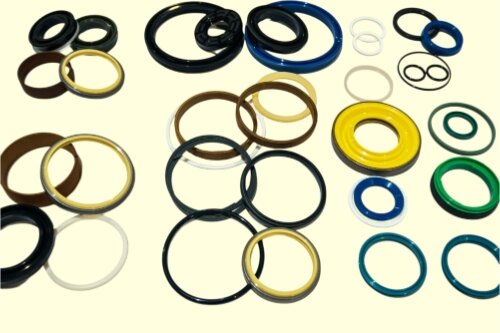
代表的な漏水箇所とその修理方法
ほとんどの水漏れは、可動部品や金具の位置から始まる。このような場所は特に注意が必要です。
ヒンジ
ヒンジはドアが動くとずれることがあります。このずれにより、ヒンジ側の圧縮が減少します。盛り上がったリップや成形されたガスケットは、連続的なシールの維持に役立ちます。補強されたヒンジプレートは、ドアのアライメントを保ちます。
ファスナー
ネジは、ネジ山に沿って小さな水の通り道を作る。シーリング・ワッシャーは、これらの通り道をふさぎます。ガスケット内蔵のキャプティブ・ファスナーも役立ちます。溶接スタッドは、貫通穴をなくし、水漏れの経路をなくします。
ケーブル・エントリー
ケーブルは引っ張られると動き、隙間ができる。ケーブルグランドは、ケーブルの周囲を圧縮し、水の浸入を防ぐ。下向きの入口は、雨がケーブルに沿ってエンクロージャーに入るのを防ぎます。
アクセスドア
大きなドアは荷重がかかると曲がります。この曲がりはガスケットの圧縮を壊します。シールラインを安定させるために、補強材を追加したり、ラッチを強化したり、デュアル・シール・パスを追加したりすることができます。
製造・組立要因
強力な設計も、適切な製造方法がなければ失敗する可能性があります。溶接、曲げ、組み立てのすべてが、エンクロージャーの密閉度を左右します。
溶接と曲げの品質
溶接は金属の形状を変える。熱が冷めるとパネルが内側に引っ張られる。この動きがシーリング・フランジを曲げ、ガスケット圧力を下げる。わずかな歪みでも、水を通す低圧スポットが生じます。溶接順序を管理し、適切な固定具を使用すれ ば、このリスクを軽減することができます。
連続溶接は、多くのリーク経路を取り除きますが、清潔を保たなければなりません。汚れ、錆、油分によってピンホールやマイクロクラックが生じることがあります。これらの微小な開口部からは、圧力下で水が浸入します。また、水分を閉じ込め、継手内部の腐食を引き起こします。
曲げはシール面にも影響する。鋭利な曲げは金属に応力を与え、近くの部分を歪ませます。金型が摩耗したり、金型に一貫性がなくなったりすると、生産ロットごとに曲げ角度が異なります。このような変化によってシーリングフランジが傾き、ガスケットは平らではなくなります。
組み立ての一貫性
アッセンブリーは最終的なシール圧力をコントロールする。どんなに優れたガスケットでも、圧縮が均一でなければ失敗する。
ファスナーのトルクは設定された範囲内に収まっていなければなりません。トルクが小さすぎると緩んだ部分ができる。トルクが大きすぎるとガスケットがつぶれ、反発が低下する。反発力が低下すると、温度変化後にガスケットがうまくシールできなくなります。トルクツールやプリセットドライバーは、圧力を一定に保つのに役立ちます。
ガスケットの取り付けは繰り返し可能でなければならない。伸びたガスケットはその形状を失う。ガスケットがねじれると小さな溝ができる。ガスケットが溝の外に置かれると、角に隙間ができます。ガスケットが平らで、溝に沿って均等に配置されていることを目視で確認します。
ガスケットの圧縮は、製造工程全体で一致させる必要があります。各ユニットが同じ手順を踏めば、ガスケットは毎回同じように圧縮されます。これにより、IPテストや実際の使用時に予測可能な結果が得られます。
検査とリークテスト
試験は、エンクロージャが目標定格を満たしているかどうかを確認します。各試験方法は、製品が屋外や産業空間で直面する可能性のある実際の条件をシミュレートしています。
IPテストでは、ダストチャンバーまたは水スプレーを使用する。ダストテストでは、微粒子がシールを通過するかどうかをチェックする。水試験は、エンクロージャーが雨、霧、圧力にどのように対処するかをチェックします。これらのテストは、繰り返されるストレスの下でシールが安定しているかどうかを示します。
水没試験は、筐体を設定された深さと時間の間、水中に沈めるものである。これらのテストはIP67とIP68の設計にとって重要です。小さな気泡でもリーク箇所を示します。これらの不具合は、角の弱さ、圧縮の低さ、フランジのゆがみなどを特定するのに役立ちます。
圧力スプレー試験は、洗浄条件をシミュレートします。高圧の水が様々な角度からエンクロージャーに当たります。この試験では、ファスナー、ヒンジ、アクセスドアが強力なスプレーに耐えられるかどうかを確認します。負荷がかかってもシーリング圧力が維持されることを確認するのに役立ちます。
結論
強力なエンクロージャーは、明確な保護目標から始まります。設計の各ステップは、最後のステップの上に構築されます。環境は要求を設定します。素材が基本的な強度を提供する。構造は水の動きを制御します。シールがバリアを形成します。ハードウェアが圧縮を維持します。製造工程が形状を安定させます。
書類上の高いIP等級は、長期的な保護を保証するものではありません。実際の性能は、平らなパネル、安定したガスケット圧縮、安全なハードウェア、一貫した組み立てによって決まります。長期的な挙動を考慮して設計すれば、現場での故障やサービスコール、ダウンタイムを減らすことができます。
エンクロージャーの設計見直しのお手伝いが必要な場合、 図面や要望を共有できる.ガスケット選択、材料選択、フランジレイアウト、溶接管理、IPテスト計画などのガイダンスを得ることができます。短時間のレビューで、生産開始前に多くのシーリング問題を防ぐことができます。
よくあるご質問
屋外用エンクロージャのIP等級は?
IP65またはIP66は、雨、ほこり、風によるしぶきに対応します。IP67またはIP68は、エンクロージャが常水や短時間の水没に直面する可能性がある場合に適しています。
沿岸地域で腐食に強い素材は?
ステンレス鋼や処理されたアルミニウムがよく機能する。紫外線に安定したプラスチックや複合材も軽い負荷には有効です。粉体塗装や陽極酸化処理は、長期的な耐性を向上させます。
ガスケットの交換頻度は?
ガスケットは定期点検時にチェックできる。平らになったり、亀裂が入ったり、反発力がなくなったりしたら交換してください。高熱や化学的ストレスがかかると、より頻繁な交換が必要になる場合があります。
板金エンクロージャーはIP67に達しますか?
平らなシーリングフランジ、安定したガスケット圧縮、密閉されたファスナーまたは溶接されたスタッド、一貫した組み立てが必要です。水没テストに合格するためには、小さな隙間はすべて取り除かなければなりません。

ケビン・リー
レーザー切断、曲げ加工、溶接、表面処理技術を専門とし、板金加工において10年以上の実務経験があります。シェンゲンのテクニカルディレクターとして、複雑な製造上の課題を解決し、各プロジェクトにおける革新と品質の向上に尽力しています。

